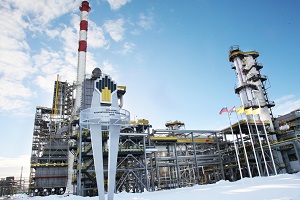Please activate JavaScript in your browser to use all interface options.
Catreforming and Isomerization units commissioned at Novokuibyshevsk Refinery
19 February 2015
Novokuibyshevsk Refinery, a Rosneft subsidiary, commissioned two key facilities - the continuous catreforming (CCR) and the low-temperature isomerization complex as part of the large-scale investment modernization program.
The start-up of these facilities will enable the Refinery, which has already mastered the production of various types of Euro 4 and Euro 5 motor and diesel fuels, to produce high-octane gasolines of the top ecological class and to decommission the old units installed back in 1960-70. Due to the construction of the units new state-of-the-art refining technologies and production control systems at the rate of the best world practices were introduced and industrial standards and safety levels improved.
The CCR complex with the annual feed rate of 1.2 mmt is designed to produce a low-sulfur high-octane component (102 octane grade) for production of commercial motor fuels of the environmentally cleanest Euro 5 standard (Class 5 of the Technical Regulations of the Customs Union). Continuous catalyst regeneration is the special feature distinguishing the new complex from the old ones, making it possible to maintain stable catalyst activity over long periods of time.
The low-temperature isomerization complex with its annual feed rate of 280 kt will produce a low-aromatic high-octane component for commercial motor fuels. It will employ a high performance, low-temperature platiniferous catalyst to generate an isomerization product of no less than 88 octane grade. This unit’s output will contain no benzenes, aromatics or sulfur compounds.
Samaraneftekhimproekt acted as general designer of the complexes, other Russian design institutions and international engineering companies were also involved.
Besides the reforming and isomerization units, the key project of the Novokuibyshevsk Refinery modernization program involved the construction of a combined heavy ends hydrocracking complex with an overall throughput of 4.8+ mtpa which, when commissioned, will help significantly boost the Refinery’s oil conversion ratio by yielding more light products.
Once Rosneft's investment program for the Novokuibyshevsk Refinery is complete, oil conversion ratio will reach 95%, while the commissioning of all units will help reduce environmental impact by 25%.
The future development plans of the enterprise include increasing the output of light products, achieving higher conversion ratios, revamping the delayed coking unit to reach the designed feed rate of 1.5 mtpa and building a new 2 mtpa AVD-2 unit. When implemented, these projects will enable boosting the Refinery’s crude throughput to 8.2 mtpa by increasing oil conversion ratio to 97%.
|
Notes for editors: Novokuibyshevsk Refinery belongs to Rosneft's Samara refinery group. The Novokuibyshevsk Refinery was commissioned in 1951. This was the country's first refinery to manufacture many types of products: jet fuels, rocket and motor lubricants etc. The Refinery's current crude distillation throughput totals 8.8 mtpa. In 2014 the Novokuibyshevsk Refinery continued implementing measures designed to elevate oil conversion ratios and light products yields and thus increased its production of premium motor and diesel fuel grades. |
Rosneft Information Division
Tel.: + 7 (499) 517-88-97
February 19, 2015

-315xx70.png)

